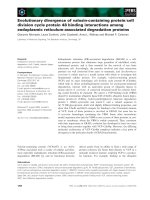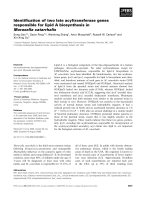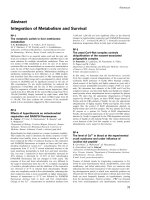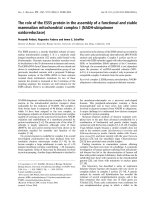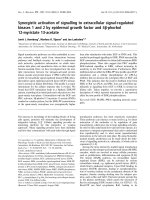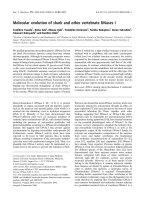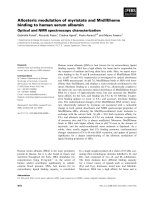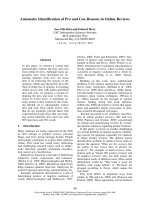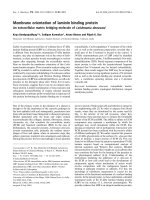Báo cáo khoa học: Acute activation of Erk1/Erk2 and protein kinase B/akt proceed by independent pathways in multiple cell types ppt
Bạn đang xem bản rút gọn của tài liệu. Xem và tải ngay bản đầy đủ của tài liệu tại đây (397.55 KB, 13 trang )
Acute activation of Erk1/Erk2 and protein kinase B/akt
proceed by independent pathways in multiple cell types
Doris Chiu, Kewei Ma, Alexander Scott and Vincent Duronio
Department of Medicine, University of British Columbia and Vancouver Coastal Health Research Institute, Jack Bell Research Centre,
Vancouver, Canada
A complex network of signaling pathways is activated
in cells in response to various cytokines and growth
factors. Understanding the interactions that occur in
these networks is complicated by the fact that, in var-
ious cell types, the same type of stimulation may trig-
ger different sets of signaling cascades. Thus, analysis
of the same signaling pathways operating in different
cell types can lead to a variety of conclusions. In our
laboratory, we are interested in the relationship
between activation of two major signaling pathways:
one initiated by p21ras proteins leading to activation
of the p44 Erk1 and p42 Erk2 members of the MAPK
family [1,2], and the other initiated by the phosphati-
dylinositol 3-kinase (PtdIns3K) group of enzymes that
Keywords
cross-talk; cytokine; inhibitors; kinase;
phosphorylation
Correspondence
V. Duronio, Jack Bell Research Centre,
Rm. 255, 2660 Oak St, Vancouver,
British Columbia, V6H 3Z6, Canada
Fax: +1 604 875 4497
Tel: +1 604 875 4707
E-mail:
(Received 17 June 2005, accepted 7 July
2005)
doi:10.1111/j.1742-4658.2005.04850.x
We used two inhibitors of the signaling enzyme phosphatidylinositol 3-kin-
ase (PtdIns3K), wortmannin and LY294002, to evaluate the potential
involvement of PtdIns3K in the activation of the MAP kinases (MAPK),
Erk1 and Erk2. In dose–response studies carried out on six different cell
lines and a primary cell culture, we analyzed the ability of the inhibitors to
block phosphorylation of protein kinase B⁄ akt (PKB ⁄ akt) at Ser473 as a
measure of PtdIns3K activity, or the phosphorylation of Erk1 ⁄ 2 at activa-
ting Thr ⁄ Tyr sites as a measure of the extent of activation of MAPK ⁄ Erk
kinase (MEK ⁄ Erk). In three different hemopoietic cell lines stimulated with
cytokines, and in HEK293 cells, stimulated with serum, either wortmannin
or LY294002, but never both, could partially block phosphorylation of
Erks. The same observations were made in a B-cell line and in primary
fibroblasts. In only one cell type, the A20 B cells, was there a closer corre-
lation between the PtdIns3K inhibition by both inhibitors, and their corres-
ponding effects on Erk phosphorylation. However, this stands out as an
exception that gives clues to the mechanism by which cross-talk might
occur. In all other cells, acute activation of the pathway leading to Erk
phosphorylation could proceed independently of PtdIns3K activation. In a
biological assay comparing these two pathways, the ability of LY294002
and the MEK inhibitor, U0126, to induce apoptosis were tested. Whereas
LY294002 caused death of cytokine-dependent hemopoietic cells, U0126
had little effect, but both inhibitors together had a synergistic effect. The
data show that these two pathways are regulating very different down-
stream events involved in cell survival.
Abbreviations
BCR, B-cell antigen receptor; DMEM, Dulbecco’s modified Eagle’s medium; FBS, fetal bovine serum; GM-CSF, granulocyte–macrophage
colony stimulating factor; IGF, insulin-like growth factor; IL, interleukin; MAPK, mitogen-activated protein kinase; MEK, MAPK ⁄ Erk kinase;
PLC, phospholipase C; PMA, phorbol 12-myristate 13-acetate; PtdIns, phosphatidylinositol; PtdIns3K, phosphatidylinositol 3-kinase;
PKB, protein kinase B ⁄ akt; PKC, protein kinase C.
4372 FEBS Journal 272 (2005) 4372–4384 ª 2005 FEBS
lead to activation of downstream kinases including
protein kinase B (PKB), also referred to as akt [3–5].
The possible relationship between PtdIns3K and Erk
activation may differ among cell types, as alluded to
above, based on numerous studies that seemed to have
reached opposing conclusions. Some studies have sug-
gested that PtdIns3K activation is required for activa-
tion of Erk [6–11], whereas other studies have shown
that PtdIns3K activation is independent of Erk activa-
tion [12–14]. However, because a variety of techniques
has been used to determine the connection between
these pathways, the conclusions may or may not be
correct in all cases, as discussed below. Understanding
whether two pathways function independently may be
important for potential attempts to target signaling
events for therapeutic reasons. Clearly, if there is con-
siderable cross-talk between the two pathways, drugs
acting on one of the pathways may also alter the
other. In other words, the effects of a drug acting at
an early point in the PtdIns3K ⁄ PKB pathway may be
very different depending upon whether the Erk signa-
ling pathway is also activated by PtdIns3K-dependent
events. Our study was designed to further address this
issue of PtdIns3K activation and its relationship to
Erk activation in a broad range of cell types.
Activation of PKB ⁄ akt has been shown to depend
upon the production of 3-phosphorylated inositol
phospholipids formed as a result of PtdIns3K activity
[15,16]. The phosphorylation of PKB at Thr308 by an
intermediate PtdIns-dependent kinase, termed PDK-1,
is a well-characterized event. PKB phosphorylation at
Ser473 is also important for full activation, with the
mechanism of this activation being clarified with the
publication of the structure of PKB [17], although
more than one kinase has been proposed to phos-
phorylate this site [18,19]. There is no good evidence
that components of the ras ⁄ Erk pathway have effects
on the pathway leading to activation of PKB, except
for the demonstration that p21ras, via its activation
loop, can bind to and activate the p110 catalytic sub-
unit of PtdIns3K [20]. The total contribution of p21ras
to PtdIns3K activation is difficult to determine, but
may primarily be seen with oncogenic forms of ras.
However, it is clear that activation of PtdIns3K has
been shown to occur in the absence of p21ras or
Erk activation [21]. It has been suggested that the
PtdIns3K pathway can lead to Erk activation,
although in earlier studies, much of the evidence for
the connection was based on the effects of wortmannin
as a PtdIns3K inhibitor [6,22], which is now known to
be insufficient proof of the role of PtdIns3K due to
the effects of this inhibitor on multiple targets. Some
studies have drawn conclusions based on use of
dominant negative versions of p85 [10,23], but one
must also determine whether nonspecific targets are
being blocked due to binding of the overexpressed p85
SH2 domains to additional targets. Another potential
cross-talk between the PtdIns3K and ras-Erk pathways
has been shown to result from the direct phosphoryla-
tion of raf by PKB, which can contribute to an inhibi-
tion of raf and thus inhibition of Erk activation
[24,25]. Intriguingly, these studies have shown that this
inhibition is observed in differentiated myotubes, but
not in the undifferentiated myoblast cells, implicating
other regulatory events controlling the phosphoryla-
tion. Perhaps the most convincing study to address the
issue of cross-talk between PtdIns3K and Erk path-
ways is that of Jacob et al. [26], which showed in sev-
eral ways that in both primary B cells and a B-cell
line, full activation of Erks was dependent upon the
activation of PtdIns3K.
Several years ago, our group showed, by use of
two different PtdIns3K inhibitors, LY294002 and
wortmannin, that LY294002 had no effect on Erk
activation in response to cytokines when PtdIns3K
was completely blocked [13]. The conclusions of that
study relied on the fact that in different situations,
one of the two inhibitors could inhibit Erks, whereas
the other could not, at inhibitor concentrations that
completely blocked PtdIns3K activity. Although
those results seemed quite conclusive, we felt that
the question had to be addressed again, because a
subsequent study, using a different hemopoietic cell
line, suggested that activation of PtdIns3K may
impinge on different isoforms of raf and thus affect
Erk activation [10]. These results were based on the
use of wortmannin (but not LY294002) as well as
dominant negative forms of PtdIns3K. The latter
study used a different cytokine-dependent hemopoietic
cell line and suggested that the differences with the
study of Scheid & Duronio [13] were due to differ-
ences in cell type. Therefore, in this study we
addressed the question of how the PtdIns3K inhibi-
tors affect activation of Erks in a number of differ-
ent cell types, hemopoietic and nonhemopoietic, and
including the FDC-P1 cells used by Sutor et al. [10].
An additional part of this study served to reinforce
the distinction between PtdIns3K- and Erk-regulated
events to verify that the PtdIns3K pathway was
indeed the more dominant in determining cytokine-
dependent survival of cells. Thus, we compared the
apoptosis of the hemopoietic cells in the presence of
PtdIns3K and MEK inhibitors to show that inhibi-
tion of MEK could only have a significant contribu-
tion to the onset of apoptosis when PtdIns3K
activity was also blocked.
D. Chiu et al. PtdIns3K activity is not required for Erk activation
FEBS Journal 272 (2005) 4372–4384 ª 2005 FEBS 4373
Results and Discussion
Differential effect of wortmannin and LY294002
on Erk activation in FDC-P1 cells
In previous studies, we showed that cytokine-activated
Erks were differentially affected by the two inhibitors
of PtdIns3K, LY294002 and wortmannin, in MC ⁄ 9
mast cells [13], which led to our conclusion that the
activation of PtdIns3K could be dissociated from acti-
vation of the pathway leading to Erk activation. We
decided to re-address this issue in multiple cell types,
beginning with FDC-P1 cells, to determine whether
our initial results were limited to a particular cell line.
Cytokine-starved FDC-P1 cells were treated with
PtdIns3K inhibitors, LY294002 and wortmannin, or
the MEK inhibitor, U0126 at varying concentrations
for 10 min. The cells were then stimulated with either
granulocyte–macrophage colony stimulating factor
(GM-CSF; 10 ngÆmL
)1
) or synthetic interleukin (IL)-3
(10 lgÆmL
)1
) for 5 min. The cells were then lysed and
proteins were isolated for immunoblotting. From the
immunoblots (Figs 1 and 2) we observed that in both
GM-CSF and IL-3 treated cells the phosphorylation of
Erks was not reduced by LY294002 even at concentra-
tions higher than those that completely blocked phos-
phorylation of PKB; however, wortmannin did reduce
the level of Erk phosphorylation. Thus, these results
are entirely consistent with those that we had obtained
previously in MC ⁄ 9 cells [13].
The two bands indicated as phosphorylated Erk1
and Erk2 in FDC-P1 cell extracts (Figs 1 and 2) cor-
responded to bands detected with anti-Erk serum (data
not shown). The nature of the lower two bands, which
were not detected with the anti-Erk serum, is not
known, but these have only been detected with anti-
(phospho-Erk) serum in FDC-P1 cells. Although we
cannot be certain at this point, they may be degrada-
tion products of phosphorylated Erk1 and Erk2 that
are not detected with the anti-Erk serum we used,
because their relative intensity correlated with that of
the Erk bands in the same samples. In addition, detec-
tion of both pairs of bands with the anti-(phospho-
Erk) serum was eliminated when cells were treated
with the MEK inhibitor (Fig. 2).
The effect of wortmannin in reducing Erk phos-
phorylation in FDC-P1 cells was also seen in a previ-
ous study [10], but the effects of LY294002 were never
compared. Both LY294002 and wortmannin blocked
phosphorylation of PKB completely at Ser473 as
expected, because it may be closely correlated to
PtdIns3K inhibition. In FDC-P1 cells, complete inhibi-
tion by the PtdIns3K inhibitors was seen at 10 lm
LY294002, but the effective concentration of these
Fig. 1. FDC-P1 cells pretreated with LY294002 and wortmannin fol-
lowed by stimulation with GM-CSF. FDC-P1 cells were starved of
cytokine overnight. Cells were pretreated with PtdIns3K inhibitors,
LY294002 and wortmannin at the indicated concentrations for
10 min. Ccells were then stimulated with GM-CSF (10 ngÆmL
)1
) for
5 min. Cell lysates were fractionated using 9% SDS ⁄ PAGE and
immunoblotted for anti-(phospho-PKB) (P-S473-PKB) or anti-(phos-
pho-ERK1 ⁄ 2) (P-ERK1, P-ERK2). The levels of p85 were used for
normalization.
Fig. 2. FDC-P1 cells pretreated with LY294002 and wortmannin fol-
lowed by stimulation with IL-3. FDC-P1 cells were starved of cyto-
kine overnight. Cells were pretreated with PtdIns3K inhibitors,
LY294002 and wortmannin. Also MEK inhibitor, U0126 was used at
the indicated concentrations for 10 min. Cells were then stimulated
with IL-3 (10 lgÆmL
)1
) for 5 min. Cell lysates were fractionated
using 9% SDS ⁄ PAGE and immunoblotted as for Fig. 1.
PtdIns3K activity is not required for Erk activation D. Chiu et al.
4374 FEBS Journal 272 (2005) 4372–4384 ª 2005 FEBS
inhibitors may vary among different cell types, as
shown below. Because we have found that the dose–
response to either LY294002 or wortmannin can vary
among different cell types, it is possible that nonselec-
tive effects of the inhibitors can be avoided by a more
careful use of dose–response studies to verify the con-
centration at which PtdIns3K is inhibited. This is also
relevant with respect to time of preincubation, because
longer preincubation times would likely require lower
concentration of inhibitors to achieve equivalent intra-
cellular concentrations. The MEK inhibitor, U0126
completely inhibited the IL-3-induced activation of
Erks without affecting PKB phosphorylation, as expec-
ted (Fig. 2). In virtually all aspects, the data obtained
with FDC-P1 confirmed our observations made in the
murine mast cell line, MC ⁄ 9 [13].
Both wortmannin and LY294002 do not affect
the activation of Erks in TF-1 cells
Next we investigated the relationship of PtdIns3K acti-
vation and Erk activation in a human hemopoietic cell
line, TF-1 which was derived from an erythroleukemic
patient [27]. The GM-CSF-starved TF-1 cells were
treated with PtdIns3K inhibitors, LY294002 and wort-
mannin, and the MEK inhibitor, U0126, at various
concentrations for 10 min. The cells were then stimula-
ted with GM-CSF for 5 min. The immunoblots of cell
lysates (Fig. 3A) showed that neither LY294002 nor
wortmannin reduced the phosphorylation of Erks at
concentrations at which PKB phosphorylation was
completely inhibited. U0126 completely blocked the
activation of Erks, without affecting PKB phosphory-
lation. Surprisingly, these results are somewhat differ-
ent from those seen previously in the FDC-P1 and
MC ⁄ 9 cells. In the TF-1 cells, neither PtdIns3K inhib-
itor had effects on the Erks. It should be noted that in
Fig. 3A the source of GM-CSF was the conditioned
medium that was used to grow these cells. However, a
more robust phosphorylation response was observed
when recombinant GM-CSF was used to stimulate the
cells (Fig. 3B). When a dose–response was performed
with LY294002, it was apparent that 10 lm LY294002
was not sufficient to block PKB phosphorylation in
the latter case. However, again, no effect was seen on
Erk phosphorylation even when 50 lm LY294002 was
used. In other experiments, use of a range of GM-CSF
doses also showed that the addition of LY294002 had
no effect on Erk phosphorylation (data not shown).
Thus, these results suggest that the lack of effect of
LY294002 on Erk is independent of the concentration
of cytokine used for stimulation. This result is not
entirely consistent with a study suggesting that differ-
ential effects may be observed with the PtdIns3K
inhibitor wortmannin, depending on the concentration
of activator used [28]. Furthermore, it has been shown
[29] that PtdIns3K lipid products may play a permis-
sive role in activation of Erks in response to low con-
centrations of EGF, but this does not appear to be the
case with cytokine activation.
Effect of PtdIns3K inhibitors in BAF-3 cells
Another commonly used hemopoietic cell line, BAF-3,
was also tested in similar assays. This is a pro-B-cell
A
B
Fig. 3. TF-1 cells pretreated with various inhibitors followed by sti-
mulation with GM-CSF. TF-1 cells were starved of cytokine over-
night. (A) Cells were pretreated with LY294002 or MEK inhibitor,
U0126, at the indicated concentrations for 10 min. Cells were then
stimulated with GM-CSF (10% CGM1) for 5 min. Cell lysates were
fractionated using 9% SDS ⁄ PAGE and immunoblotted for anti-
(phospho-Ser473-PKB) or anti-(phospho-ERK1 ⁄ 2). The levels of p85
were used for normalization. (B) Cells were treated with a range
of concentrations of LY294002, followed by stimulation with
10 ngÆmL
)1
recombinant human GM-CSF. A control in which cells
were incubated with solvent (dimethylsulfoxide) was included.
D. Chiu et al. PtdIns3K activity is not required for Erk activation
FEBS Journal 272 (2005) 4372–4384 ª 2005 FEBS 4375
line [30], which is dependent upon IL-3 for growth and
survival, and is distinct from the usual myeloid cells
used to study IL-3 responses. This cell line is also un-
usual in that it is easily transfectable, unlike most
other hemopoietic cell types, and thus it may be quite
different from other cytokine-dependent hemopoietic
cells. In our studies, we used these cells to compare the
effects of LY294002 and wortmannin on PKB and Erk
phosphorylation, and the results obtained were similar
to those seen in TF-1 cells, because neither inhibitor,
at the low concentrations used to completely block
PKB phosphorylation, had any effect on Erk phos-
phorylation (Fig. 4). Again, these results allow us to
conclude that there is not a role for the PtdIns3K
pathway in Erk activation. It is interesting to note that
other studies have shown that a dominant negative
form of the p85 subunit of PtdIns3K was able to block
Erk activation in BAF-3 cells [23], which we argue
may be due to a nonselective effect of expressing a p85
mutant whose SH2 domains could conceivably bind to
other targets upstream of the MEK ⁄ erk pathway. In
contrast to the results shown in Fig. 4, the study by
Craddock et al. [20] paradoxically showed inhibitory
effects of LY294002 on Erk phosphorylation, a dis-
crepancy that may be attributed to differences in dose
and time of treatment. Those authors utilized 10 lm
LY294002 as the lowest concentration, with a preincu-
bation time of 30 min. We show here that concentra-
tions of LY294002 up to 10 lm, preincubated with
cells for 10 min, had no effect on Erk phosphorylation,
but almost completely blocked PKB phosphorylation.
When we used higher concentrations (25 or 50 lm)of
LY294002 under these conditions, inhibition of Erk
phosphorylation was observed (data not shown). Most
importantly, at concentrations of wortmannin where
PtdIns3K was completely inhibited, we show that there
was no change in phosphorylation of the Erks. Thus,
it is important to re-emphasize that it is valuable to
use both of the PtdIns3K inhibitors and compare their
effects when trying to determine downstream events
that may be regulated by PtdIns3K.
Potential cross-talk in B cells
The activation of B cells via the B-cell antigen receptor
has been a widely used model system for signal trans-
duction studies [31,32]. In a recent study, [26] the role
of the PtdIns3K pathway in regulation of Erk activity
was investigated using A20 as well as primary B cells.
Thus, we tested murine A20 cells as well as another
B-cell line, the human BJAB cells, which were both
derived from B lymphomas. Consistent with previous
results [26] we observed that inhibition of PtdIns3K
activity with LY294002 in A20 cells caused a parallel
inhibition of Erk phosphorylation (Fig. 5). Most nota-
bly, at 5 lm LY294002, there was a decrease in PKB
phosphorylation as well as a decrease in Erk phos-
phorylation. Higher concentrations of LY294002 could
completely inhibit PKB phosphorylation, and caused
greater inhibition of ERK phosphorylation. However,
in the human BJAB cell line, there was not as great an
effect of LY294002 on Erk phosphorylation, because
0.5–2.0 lm LY294002 caused noticeable inhibition of
PKB phosphorylation, whereas ERK phosphorylation
was unaffected. There was some inhibition of ERK
phosphorylation in BJAB cells in response to higher
concentrations of LY294002. Parallel experiments car-
ried out using wortmannin showed that this inhibitor
affected both PKB and ERK phosphorylation in a
similar manner to LY294002 in both of these cell lines
(data not shown). Thus, in the two B-cell lines, there
was clearly some involvement of PtdIns3K activation
in activation of the Erks, even if it is much more obvi-
ous in the A20 cells than BJAB cells.
One can assume that the reason for the cross-talk
between the two pathways in B cells, which is different
from growth factor-induced activation, may be attri-
buted to the involvement of Btk downstream of B-cell
antigen receptor (BCR) activation [33]. This tyrosine
kinase is known to be dependent upon PtdIns3K-gen-
erated PtdIns lipids, because it has a PH domain that
is necessary for its activation [34]. Furthermore, Btk is
Fig. 4. BAF-3 cells pretreated with LY294002 and wortmannin fol-
lowed by stimulation with IL-3. BAF-3 cells were starved of cyto-
kine overnight. Cells were pretreated with PtdIns3K inhibitors,
LY294002 and wortmannin or MEK inhibitor, U0126 at the indicated
concentrations for 10 min. Cells were then stimulated with IL-3
(10 lgÆmL
)1
) for 5 min. Cell lysates were fractionated using 9%
SDS ⁄ PAGE and immunoblotted for anti-(phospho-Ser473-PKB), anti-
(phospho-ERK1 ⁄ 2). Ponceau S staining was used to verify equal
loading of total protein between lanes (not shown).
PtdIns3K activity is not required for Erk activation D. Chiu et al.
4376 FEBS Journal 272 (2005) 4372–4384 ª 2005 FEBS
responsible for phosphorylation of phospholipase Cc
(PLCc) and the subsequent generation of diacylglycerol
and Ca
2+
release [35], which result in protein kinase C
(PKC) activation. While other tyrosine kinases may
also be involved in ras activation downstream of the
BCR, it is clear that activation of PLCc and PKC are
also intimately involved in the pathway leading to Erk
activation in B cells [36].
Effects of PtdIns3K inhibitors in HEK293 cells
We also wanted to examine nonhemopoietic cells to
observe the relationship between PtdIns3K and Erks.
We decided to use the commonly used human epi-
thelial kidney cell line, HEK293. HEK293 cells were
serum-starved, and treated with inhibitors at various
concentrations for 10 min. The cells were then stimula-
ted by the re-addition of 10% fetal bovine serum
(FBS) for 10 min. The cells were lysed and proteins
were isolated for immunoblotting. HEK293 cells dif-
fered from the previous cell lines used as seen by the
presence of low levels of endogenous phosphorylated
Erks in the unstimulated lane (Fig. 6). However, no
phosphorylated PKB was observed in the serum-
starved cells.
Concentrations of LY294002 from 10 to 50 lm,
which blocked the phosphorylation of PKB, partially
blocked the phosphorylation of Erks. When the effects
of wortmannin were tested, concentrations of wort-
mannin much higher than that needed to block
PtdIns3K, did not seem to affect Erk phosphorylation.
U0126, as seen in the previous three cell lines, com-
pletely blocked the activation of Erks, without any
effect on PKB. These results suggest either that
LY294002 may have some nonspecific effects in this
particular cell line, or it may be that LY294002 selec-
tively affects a component of the pathway leading to
Erk activation in response to serum stimulation. Inter-
estingly, we showed previously that phorbol ester sti-
mulated Erk activation in MC ⁄ 9 cells showed a similar
response, because it could be partially inhibited by
LY294002, whereas wortmannin had no effect [13]. In
any event, the fact that one of the two PtdIns3K inhi-
bitors blocked PKB phosphorylation without any
A
B
Fig. 5. B-cell lines stimulated pretreated
with LY294002 and stimulated via the B-cell
antigen receptor. The two B-cell lines, A20
and BJAB, were stimulated via the B-cell
receptor as described in Experimental proce-
dures, following preincubation with various
concentrations of LY294002. Samples were
immunoblotted for anti-(phospho-Erks) or
anti-(phospho-Ser473-PKB).
D. Chiu et al. PtdIns3K activity is not required for Erk activation
FEBS Journal 272 (2005) 4372–4384 ª 2005 FEBS 4377
effect on Erk phosphorylation supports the conclusion
that the two pathways are independently controlled.
Effects of PtdIns3K inhibitors in tendon fibroblast
cells
We also examined the effects of LY294002 and UO126
on Erk and PKB phosphorylation in primary tendon
fibroblasts cells. The cells were extracted from porcine
Achilles tendon (dissected free of peritendinous tissues)
by collagenase digestion and cultured up to the fifth
passage in Dulbecco’s modified Eagle’s medium
(DMEM) containing 10% FBS. Prior to the experi-
ments, the cells were trypsinized and replated at
500 000 cells ⁄ 60 mm plate. After adhering overnight,
the cells were stimulated with various doses of insulin-
like growth factor (IGF)-I with or without 10 min pre-
treatment with graded doses of LY294002 or UO126.
After stimulation with IGF-I for 5 min, cells were
scraped and pelleted, then lysed and immunoblotted as
described above. There was considerable phosphory-
lated PKB and Erks in unstimulated cells, mainly
because no serum starvation was done with these cells
(Fig. 7). Most importantly, at 25 lm LY294002, PKB
phosphorylation was completely blocked, but no effect
was observed on Erk phosphorylation. If anything,
there was increased phosphorylation of Erks following
treatment with LY294002, suggesting that the
PtdIns3K pathway may have an inhibitory effect on
Erk activation. We have not pursued this question suf-
ficiently to determine its significance. However, cross-
talk between PKB and raf has been suggested to be
inhibitory towards Erk activation in specific cases
[37,38]. We found that 10 lm UO126 was sufficient to
block Erk phosphorylation, but the highest dose of
UO126 tested (50 lm) caused no reduction in PKB
phosphorylation. Conversely, 10 lm LY294992 only
partially reduced PKB phosphorylation, whereas the
higher doses eliminated it, without causing any reduc-
tion in the levels of Erk phosphorylation. In support
of our findings, another study showed that IGF-I,
insulin and platelet-derived growth factor stimulation
of Erks was not affected by a PtdIns3K inhibitor [39].
Analysis of inhibitor effects on induction
of apoptosis
In numerous studies [40–44], including our own
10 years ago using MC ⁄ 9 cells [45], the importance of
the PtdIns3K pathway in blocking apoptosis has been
highlighted. Furthermore, we showed that blocking the
Erk pathway with a MEK inhibitor, PD98059, did not
cause apoptosis over the same time frame as that seen
with PtdIns3K inhibitors (VD, unpublished observa-
tions). We wished to address this issue more carefully
in cytokine-dependent cells using the MEK inhibitor,
U0126, which is a more potent inhibitor of Erk activa-
tion [46]. As can be seen from Fig. 8, which summar-
izes flow cytometry analysis of propidium iodide
staining for subdiploid DNA, the use of the PtdIns3K
inhibitor LY294002, caused apoptosis of all three cell
Fig. 7. Primary porcine tendon fibroblasts pretreated with
LY294002 followed by stimulation with IGF-I. Porcine tendon fibro-
blasts were preincubated with or without LY294002 at the indica-
ted concenrations for 10 min followed by 5 min stimulation with
IGF-I. Samples were fractionated on SDS ⁄ PAGE and immunoblot-
ted for phospho-Erk or phospho-Ser473 PKB.
Fig. 6. HEK293 cells pretreated with LY294002 and wortmannin
followed by stimulation with FBS. HEK293 cells were starved of
FBS overnight. Cells were pretreated with PtdIns3K inhibitors,
LY294002 and wortmannin or MEK inhibitor, U0126 at the indicated
concentrations for 10 min. Cells were then stimulated with 10%
FBS for 10 min. Cell lysates were fractionated using 9%
SDS ⁄ PAGE and immunoblotted for anti-(phospho-PKB), anti-(phos-
pho-ERK1 ⁄ 2) and the levels of p85 were used for normalization.
PtdIns3K activity is not required for Erk activation D. Chiu et al.
4378 FEBS Journal 272 (2005) 4372–4384 ª 2005 FEBS
types, MC ⁄ 9, FDC-P1 and BAF-3, whereas U0126
had almost no effect over a 16 h period. Interestingly,
the addition of both inhibitors together had a greater
effect on apoptosis, which suggests that in the absence
of PtdIns3K activity, Erk activation may provide some
survival effect. This may not be surprising because the
ras ⁄ Erk pathway has been shown to have antiapop-
tosis effects [47].
Conclusions
The two inhibitors of PtdIns3K, LY294002 and wort-
mannin, are useful when used under the same condi-
tions, in parallel experiments, to study the importance
of PtdIns3K in various signaling pathways, because
they have different mechanisms of action and different
pharmacological profiles. However, as with any phar-
macological agents, there are other targets affected by
each of the inhibitors [48–50] and thus one has to be
cautious with interpretation of data. We have shown
that the effects of wortmannin and LY294002 on inhi-
bition of Erk activation can vary, depending upon the
cell type and agonist being used. When the two inhibi-
tors both inhibit PtdIns3K in a dose-dependent fash-
ion, and yet have differential effects on downstream
events, this must dissociate PtdIns3K activation from
being directly involved in these other events. If the
activation of PtdIns3K was required for a certain
downstream event, then complete inhibition of the
PtdIns3K pathway with either inhibitor should have
equivalent effects.
We addressed the issue of cross-talk between the
PtdIns3K and ras ⁄ Erk pathways in two previous stud-
ies [13,51]. One of the reasons we decided to re-visit
this problem was the publication of a study which sug-
gested that in FDC-P1 cells, PtdIns3K impinged on
the ras to Erk pathway via differential effects on raf
isoforms [10]. In that study, it was suggested that the
difference from our work using MC ⁄ 9 cells may be
due to the difference in cell types, yet those authors
failed to test the effects of LY294002, relying largely
on the effect of dominant negative PtdIns3K con-
structs and the inhibitor wortmannin. Thus, we initi-
ated the study of a number of cell types, including the
FDC-P1 cells used in a previous stusy [10] to compare
the effects of wortmannin and LY294002 on activation
of Erk1 ⁄ 2. The results support our previous conclu-
sion, using MC ⁄ 9 cells, that in most cases, inhibition
of PtdIns3K does not affect the activation of Erk1 ⁄ 2.
In fact, the only case in which we have seen evidence
for the involvement of PtdIns3K in Erk activation was
the A20 B-cell line, which is explained by the role of
PtdIns3K in activating Btk and PLCc, and subse-
quently activation of Erks [33].
One of the more compelling results is the difference
in inhibition seen with the inhibitors in the various cell
types. Results in FDC-P1 were consistent with those
seen previously in MC ⁄ 9 cells, because inhibition with
wortmannin could partially reduce Erk activation,
whereas LY294002 had no effect. However, neither
inhibitor had any effect on Erk activation in TF-1
cells. In the BAF-3 cells, there was some effect of
higher concentrations of LY294002 in blocking Erk
activation, but no effect was observed with wort-
mannin when PKB phosphorylation was blocked. In
HEK293 cells, the serum-starved cells were stimulated
by re-addition of serum rather than a specific cytokine.
In this case, in which a number of factors may be con-
tributing to activation of PtdIns3K and ras-Erk path-
ways, LY294002 was able to partially block Erk1 ⁄ 2
activation, but wortmannin did not. The latter result is
reminiscent of the effect of the inhibitors on blocking
phorbol 12-myristate 13-acetate (PMA)-induced
Erk1 ⁄ 2 activation. When MC ⁄ 9 cells were treated with
PMA, a treatment in which a ras-independent activa-
tion of the Erk pathway is implicated, wortmannin
did not inhibit the activation of Erk1 ⁄ 2, whereas
LY294002 did inhibit [13]. Therefore, the results
CON
LY
LY
+
U0126
U0126
DMSO
80
60
40
20
0
% APOPTOSIS
FDC-P1
TF-1
BAF-3
Fig. 8. Summary of apoptosis studies in the three hemopoietic cell
types. FDC-P1, TF-1 or BAF-3 cells were incubated in complete
medium containing appropriate cytokines, then treated with either
50 l
M LY294002 (LY) or 10 lM U0126, both inhibitors together, or
vehicle control (dimethylsulfoxide) for 16 h. Cells were analyzed for
the extent of apoptosis by measuring the percentage of cells con-
taining subdiploid DNA, based on propidium iodide staining.
D. Chiu et al. PtdIns3K activity is not required for Erk activation
FEBS Journal 272 (2005) 4372–4384 ª 2005 FEBS 4379
showing that in some cases, LY294002 can block Erk
activation, but wortmannin does not, whereas in others
the reverse is true, leads us to conclude that both wort-
mannin and LY294002 can have some effect on var-
ious upstream components leading to activation of
Erk1 ⁄ 2. Because these effects on Erks do not correlate
with the inhibition of PtdIns3K by the inhibitors, then
PtdIns3K activation cannot be placed upstream of Erk
activation. We have not provided new insight into the
mechanism of the inhibitors’ effects on Erk activation,
but we can make the important point that the effect of
only one of the inhibitors should not be taken as proof
for PtdIns3K dependence, and there will always be a
need for a dose–response analysis to conclusively dem-
onstrate a correlation of the inhibitors’ effects on
PtdIns3K and other downstream targets.
A recent study put forward a strong argument that
activation of Erk was dependent upon PtdIns3K in
response to c-kit receptor activation in stem cells [33].
The results in this study were compelling, because he-
matopoietic stem cell lines were compared with more
differentiated mast cells, in which blocking PtdIns3K
had no effect on Erk phosphorylation. However, it
should be noted that only single concentration of
LY29402 was used, and based on our observations, a
more careful analysis with a range of inhibitor doses
might be warranted, as this might account for the dif-
ferent effects in the different cell types.
The analysis of the effects of the PtdIns3K inhibitors
and the MEK inhibitor on induction of apoptosis pro-
vides further evidence that the PtdIns3K pathway
regulates survival events that are independent of the
Erk pathway in cytokine-dependent hemopoietic cells.
When PtdIns3K is blocked with LY294002, cells
undergo apoptosis, as reported previously [45]. It
should be noted that when cells are incubated with
50 lm LY294002 for 16 h, there may be some inhibi-
tion of Erk activation, as we have shown, but obvi-
ously this is not contributing substantially to the effect
on apoptosis, because blocking with U0126 alone has
little or no effect. We felt it was important to do these
studies using U0126, which is a more effective inhib-
itor of Erk activation than PD98059 [46], to verify that
Erk activation was not necessary for cell survival over
the 16 h time course. However, when both inhibitors
were used together, there was a synergistic effect
resulting in a greater extent of apoptosis, which sup-
ports the fact that the Erk pathway can provide some
signals important for cell survival. These results pro-
vide a functional assay of downstream events regulated
by the signaling pathways and thus support our other
studies, because blocking the two pathways individu-
ally have very different outcomes on these cells.
As we have stated previously, and can now empha-
size based on results using a variety of cell lines, it is
clear is that when the effects of PtdIns3K inhibition
are being studied, the use of only one of the two
PtdIns3K inhibitors cannot be accepted as proof that
any effects being blocked are regulated by activation
of PtdIns3K. Furthermore, it is important to note that
the type of experiment used will only assess the effects
of immediate activation of PtdIns3K on the concurrent
activation of Erk1 ⁄ 2. We have not addressed the pos-
sible effects of longer term PtdIns3K activation on
components of the Erk signaling pathway. For exam-
ple, one could imagine that there are secondary events
regulated by PtdIns3K (e.g. as seen in the B cells) that
may contribute to prolonged activation of Erks.
In conclusion, our results using pharmacological
inhibitors suggest that activation of the PtdIns3K path-
way is not required for the pathway leading to acute
activation of Erk1 and Erk2. We have shown this in sev-
eral cytokine-dependent cell types as well as an epithe-
lial cell line and primary fibroblasts. Only in one specific
B-cell line could we conclude that blocking PtdIns3K
activation had an inhibitory effect on the activation of
Erk, which is explainable based on what is known about
BCR signaling. Our study has concentrated on acute
activation of these signaling enzymes and thus has spe-
cifically addressed possible cross-talk between the path-
ways that may occur proximal to receptor activation.
Further studies will be required to address possible
inter-relationships that occur due to chronic activation
or inhibition of one of the pathways.
Experimental procedures
Cells and reagents
FDC-P1, BAF-3, TF-1, BJAB, A20 and HEK293 cells and
primary porcine Achilles tendon fibroblasts (tenocytes) were
grown at 37 °C and 5% (v ⁄ v) CO
2
with humidity. FDC-P1
and BAF-3 cells were grown in RPMI-1640 medium sup-
plemented with 10% (v ⁄ v) FBS, 20 mm 2-mercaptoethanol.
5% WEHI-3-conditioned medium was added as a source of
IL-3. The TF-1 cells were grown in RPMI-1640 medium
supplemented with 10% FBS, 20 mm 2-mercaptoethanol
and 1% conditioned medium containing recombinant
human GM-CSF (from CGM1 cells; kind gift from
C. Brown, University of Calgary, Canada). HEK293 and
primary tendon cells were grown in DMEM medium sup-
plemented with 10% (v ⁄ v) FBS, l-glutamine, sodium pyru-
vate, 50 UÆmL
)1
penicillin and 50 mgÆmL
)1
streptomycin.
The tendon fibroblasts were extracted from porcine Achilles
tendon (dissected free of peritendinous tissues) by collage-
nase digestion and cultured up to the fifth passage in
PtdIns3K activity is not required for Erk activation D. Chiu et al.
4380 FEBS Journal 272 (2005) 4372–4384 ª 2005 FEBS
DMEM containing 10% (v ⁄ v) FBS. Prior to the experi-
ments, the cells were trypsinized and replated at 500 000
cells per 60 mm plate. After adhering overnight, the cells
were stimulated with various doses of IGF-I. BJAB cells
and A20 cells were cultured in RPMI-1640 medium supple-
mented with 10% (v ⁄ v) FBS, 50 lm 2-mercaptoethanol
(A20 only) and antibiotics.
Antibodies to phosphorylated S473 of PKB ⁄ akt and
dually phosphorylated Erk1 and Erk2 were from Cell Sign-
aling Technologies (Beverly, MA, USA); antibody to the
p85 subunit of PtdIns3K was from Upstate Biotechnology
Inc. (Lake Placid, NY, USA) LY294002, wortmannin, and
U0126 were from Calbiochem (San Diego, CA). Goat anti-
[human IgM F(ab¢)
2
] and intact goat anti-(human IgM),
rabbit anti-[mouse IgG F(ab¢)
2
] and intact rabbit anti-
(mouse IgG) were purchased from Jackson Immuno-
Research (West Grove, PA, USA). IGF-I was purchased
from Sigma (St. Louis, MO, USA).
Cell treatments and lysis conditions
Cells were starved of cytokines or growth factors by over-
night incubation in medium with 1% (v ⁄ v) WEHI-3-condi-
tioned medium (for FDC-P1 and BAF-3 cells), or no
GM-CSF (for TF-1 cells) or no FBS (for HEK293 cells).
Cells were incubated at 37 °Cin20mm Hepes (pH 7.4)-
buffered RPMI-1640 prior to assay. Cells were pretreated
with PtdIns3K inhibitors, LY294002 and wortmannin or
the MEK inhibitor, U0126, at varying concentrations for
10 min. The cells were then stimulated with synthetic IL-3
(10 lgÆmL
)1
for FDC-P1 and BAF-3 cells) or recombinant
GM-CSF (10 ngÆmL
)1
; murine GM-CSF for FDC-P1 cells
and human GM-CSF for TF-1 cells) or recombinant IGF-I
(tendon cells) for 5 or 10 min. BJAB cells were stimulated
with goat anti-[human IgM F(ab¢)
2
] at the specified time
points. A20 cells were similarly stimulated with goat anti-
[mouse IgG F(ab¢)
2
]. The HEK293 or porcine tendon fibro-
blast cells were first detached from the plates in NaCl ⁄ P
i
containing 1 mm EDTA, then stimulated with 10% FBS in
microfuge tubes. In each case, to stop the reactions, cells
were pelleted and then solubilized in ice-cold lysis
buffer containing 50 mm Tris ⁄ HCl, pH 7.4, 1% (v ⁄ v)
Triton X-100, 10% (v ⁄ v) glycerol, 100 mm NaCl, 2.5 mm
EDTA, 10 mm NaF, 1 mm Na
3
VO
4
,1mm Na
3
MoO
4
,
10 mm b-glycerophosphate, 1 lgÆmL
)1
microcystin-LR,
1 lgÆmL
)1
aprotinin, 40 lgÆmL
)1
phenylmethylsulfonyl
fluoride, 1 lm pepstatin, 0.5 lgÆmL
)1
leupeptin and
10 lgÆmL
)1
soybean trypsin inhibitor. Nuclei were pelleted
by centrifuging at 16 000 g for 1 min at 4 °C and the super-
natants were transferred to new tubes, mixed with SDS
sample buffer, boiled and separated on polyacrylamide gels
prior to immunoblotting analyses. In all figures, immuno-
blots shown are representative of several experiments show-
ing similar results. Each of the analyses (except for those
done with primary fibroblasts which were done only twice)
was done a minimum of three times (and in most cases at
least five times).
Immunoblotting
Phosphorylated PKB (S473), phosphorylated Erks (pT-E-PY
motif) and p85 were visualized in the samples by running
equivalent amounts of total protein lysate (50–100 lg) on
9% SDS ⁄ PAGE gels, transferred to nitrocellulose blots.
Detection of the p85 subunit of PtdIns3K was used to show
equivalent loading. In all cases, staining of the immunoblots
with Ponceau S was also used to verify the presence of equal
amounts of protein per lane. The blots were blocked in 5%
skim milk and incubated in 1 : 1000 or 1 : 2000 dilution of
the primary antibody. The primary antibody was detected by
incubating in the appropriate secondary antibody coupled to
horseradish peroxidase and the bands were visualized using
ECL (Amersham Pharmacia Biotech, Piscataway, NJ, USA)
according to the manufacturer’s instructions.
Apoptosis analysis by staining for subdiploid
DNA content
The FDC-P1 cells, BAF-3 cells and TF-1 cells were washed
three times in sterile, 1· NaCl ⁄ P
i
prior to treatments. Cells
were resuspended in growth medium to a concentration of
1 · 10
6
cellsÆmL
)1
, without any cytokine and treated as fol-
lows. The cells were either treated with or without cyto-
kines (5% WEHI-3 and 1% GM-CSF) and with or without
inhibitors (LY294002 and U0126). The cells were incubated
at 37 °C, 5% CO
2
in humidified air for 16 or 24 h. Fixation
of the cells was modified from Current Protocols of Immu-
nology. One milliliter aliquots of the cells, following various
treatments, were collected and pelleted. The supernatant
was poured off and 1 mL of ice-cold, 70% ethanol was
added to the cells drop-wise, while vortexing. Cells were
then incubated at 4 °C for at least 18 h. The cells were pel-
leted by spinning at 3000 g for 5 min. The ethanol was
poured off and the cells resuspended in staining buffer
containing 1· NaCl ⁄ P
i
, 0.1% (w ⁄ v) dextrose, 100 lgÆmL
)1
RNaseA, 50 lgÆmL
)1
propidium iodide. The samples were
kept at room temperature, in the dark, for 45 min prior to
flow cytometry analysis.
The propidium iodide stained cells were analyzed using
a Beckman Coulter EPICS XL-MCL, flow cytometer.
expo 32 data acquisition software was used to collect the
data and expo 32 analysis software was used to analyze the
data. The background noise and autofluorescence of
the cells were gated out using the negative control sample
in the FL3 versus FS histogram. The same gate was applied
to all subsequent treatment samples. The amount of sub-
diploid DNA content was quantified using the number of
events versus FL3 histogram by marking the area starting
from the y-axis to the first largest peak, which corresponds
to the G1 cycle.
D. Chiu et al. PtdIns3K activity is not required for Erk activation
FEBS Journal 272 (2005) 4372–4384 ª 2005 FEBS 4381
Acknowledgements
This work was supported by a grant from the Cana-
dian Institutes of Health Research. DC was partially
supported by a University Graduate Fellowship. AS is
the recipient of scholarships from NSERC and the
Michael Smith Foundation for Health Research
(MSFHR). VD is a Senior Scholar of the MSFHR.
We wish to thank Mr Payman Hojabrpour for techni-
cal assistance.
References
1 English J, Pearson G, Wilsbacher J, Swantek J,
Karandikar M, Xu S & Cobb MH (1999) New insights
into the control of MAP kinase pathways. Exp Cell Res
253, 255–270.
2 Brunet A & Pouyssegur J (1997) Mammalian MAP
kinase modules: how to transduce specific signals.
Essays Biochem 32, 1–16.
3 Fruman DA, Meyers RE & Cantley LC (1998) Phos-
phoinositide kinases. Annu Rev Biochem 67, 481–507.
4 Martin TFJ (1998) Phosphoinositide lipids as signaling
molecules: common themes for signal transduction,
cytoskeletal regulation, and membrane trafficking. Annu
Rev Cell Dev Biol 14, 231–264.
5 Duronio V, Scheid MP & Ettinger S (1998) Down-
stream signalling events regulated by phosphatidylinosi-
tol 3-kinase activity. Cell Signal 10, 233–239.
6 Standaert ML, Bandyopadhyay G & Farese RV (1995)
Studies with wortmannin suggest a role for phosphati-
dylinositol 3-kinase in the activation of glycogen
synthase and mitogen-activated protein kinase by insulin
in rat adipocytes: comparison of insulin and protein
kinase C modulators. Biochem Biophys Res Commun
209, 1082–1088.
7 Von Willebrand M, Jascur T, Bonnefoy-Berard N,
Yano H, Altman A, Matsuda Y & Mustelin T (1996)
Inhibition of phosphatidylinositol 3-kinase blocks T cell
antigen receptor ⁄ CD3-induced activation of the mito-
gen-activated kinase Erk2. Eur J Biochem 235, 828–835.
8 Grammer TC & Blenis J (1997) Evidence for MEK-inde-
pendent pathways regulating the prolonged activation of
the ERK-MAP kinases. Oncogene 14, 1635–1642.
9 Bondeva T, Pirola L, Bulgarelli-Leva G, Rubio I,
Wetzker R & Wymann MP (1998) Bifurcation of lipid
and protein kinase signals of PI3Kgamma to the protein
kinases PKB and MAPK. Science 282, 293–296.
10 Sutor SL, Vroman BT, Armstrong EA, Abraham RT &
Karnitz LM (1999) A phosphatidylinositol 3-kinase-
dependent pathway that differentially regulates c-Raf
and A-Raf. J Biol Chem 274, 7002–7010.
11 Wandzioch E, Edling CE, Palmer RH, Carlsson L &
Hallberg B (2004) Activation of the MAP kinase
pathway by c-Kit is PI-3 kinase dependent in hemato-
poietic progenitor ⁄ stem cell lines. Blood 104, 51–57.
12 Cheatham B, Vlahos CJ, Cheatham L, Wang L, Blenis
J & Kahn CR (1994) Phosphatidylinositol 3-kinase acti-
vation is required for insulin stimulation of pp70, S6
kinase, DNA synthesis, and glucose transporter trans-
location. Mol Cell Biol 14, 4902–4911.
13 Scheid MP & Duronio V (1996) Phosphatidylinositol
3-OH kinase activity is not required for activation of
mitogen-activated protein kinase by cytokines. J Biol
Chem 271, 18134–18139.
14 Frevert EU & Kahn BB (1997) Differential effects of
constitutively active phosphatidylinositol 3-kinase on
glucose transport, glycogen synthase activity, and DNA
synthesis in 3T3-L1 adipocytes. Mol Cell Biol 17, 190–
198.
15 Coffer PJ, Jin J & Woodgett JR (1998) Protein kinase B
(c-Akt): a multifunctional mediator of phosphatidylino-
sitol 3-kinase activation. Biochem J 335, 1–13.
16 Scheid MP & Woodgett JR (2001) PKB ⁄ AKT: func-
tional insights from genetic models. Nat Rev Mol Cell
Biol 2, 760–768.
17 Yang J, Cron P, Thompson V, Good VM, Hess D,
Hemmings BA & Barford D (2002) Molecular
mechanism for the regulation of protein kinase B ⁄ Akt
by hydrophobic motif phosphorylation. Mol Cell 9,
1227–1240.
18 Delcommenne M, Tan C, Gray V, Rue L, Woodgett J
& Dedhar S (1998) Phosphoinositide-3-OH kinase-
dependent regulation of glycogen synthase kinase 3 and
protein kinase B ⁄ AKT by the integrin-linked kinase.
Proc Natl Acad Sci USA 95, 11211–11216.
19 Feng J, Park J, Cron P, Hess D & Hemmings BA
(2004) Identification of a PKB ⁄ Akt hydrophobic motif
Ser-473 kinase as DNA-dependent protein kinase. J Biol
Chem 279, 41189–41196.
20 Kauffmann-Zeh A, Rodriguez-Viciana P, Ulrich E,
Gilbert C, Coffer P, Downward J & Evan G (1997)
Suppression of c-Myc-induced apoptosis by Ras signal-
ling through PI(3)K and PKB. Nature 385, 544–548.
21 Gold MR, Duronio V, Saxena SP, Schrader JW &
Aebersold R (1994) Multiple cytokines activate phos-
phatidylinositol 3-kinase in hemopoietic cells. Associa-
tion of the enzyme with various tyrosine-phosphorylated
proteins. J Biol Chem 269, 5403–5412.
22 Karnitz LM, Burns LA, Sutor SL, Blenis J & Abraham
RT (1995) Interleukin-2 triggers a novel phosphatidyl-
inositol 3-kinase-dependent MEK activation pathway.
Mol Cell Biol 15, 3049–3057.
23 Craddock BL, Hobbs J, Edmead CE & Welham MJ
(2001) Phosphoinositide 3-kinase-dependent regulation
of interleukin-3-induced proliferation: involvement of
mitogen-activated protein kinases, SHP2 and Gab2.
J Biol Chem 276, 24274–24283.
PtdIns3K activity is not required for Erk activation D. Chiu et al.
4382 FEBS Journal 272 (2005) 4372–4384 ª 2005 FEBS
24 Rommel C, Clarke BA, Zimmermann S, Nunez L,
Rossman R, Reid K, Moelling K, Yancopoulos GD &
Glass DJ (1999) Differentiation stage-specific inhibition
of the Raf-MEK-ERK pathway by Akt. Science 286,
1738–1741.
25 Zimmermann S & Moelling K (1999) Phosphorylation
and regulation of Raf by Akt (protein kinase B).
Science 286, 1741–1744.
26 Jacob A, Cooney D, Pradhan M & Coggeshall KM
(2002) Convergence of signaling pathways on the acti-
vation of ERK in B cells. J Biol Chem 277, 23420–
23426.
27 Kitamura T, Tange T, Terasawa T, Chiba S, Kuwaki T,
Miyagawa K, Piao YF, Miyazono K, Urabe A &
Takaku F (1989) Establishment and characterization of
a unique human cell line that proliferates dependently
on GM-CSF, IL-3, or erythropoietin. J Cell Physiol
140, 323–334.
28 Duckworth BC & Cantley LC (1997) Conditional inhi-
bition of the mitogen-activated protein kinase cascade
by wortmannin. Dependence on signal strength. J Biol
Chem 272, 27665–27670.
29 Wennstrom S & Downward J (1999) Role of phospho-
inositide 3-kinase in activation of ras and mitogen-acti-
vated protein kinase by epidermal growth factor. Mol
Cell Biol 19, 4279–4288.
30 Palacios R & Steinmetz M (1985) IL-3-dependent mouse
clones that express B-220 surface antigen, contain Ig
genes in germ-line configuration, and generate B lym-
phocytes in vivo. Cell 41, 727–734.
31 Niiro H & Clark EA (2002) Regulation of B-cell fate by
antigen-receptor signals. Nat Rev Immunol 2, 945–956.
32 Gold MR, Ingham RJ, McLeod SJ, Christian SL,
Scheid MP, Duronio V, Santos L & Matsuuchi L
(2000) Targets of B-cell antigen receptor signaling: the
phosphatidylinositol 3-kinase ⁄ Akt ⁄ glycogen synthase
kinase-3 signaling pathway and the Rap1 GTPase.
Immunol Rev 176, 47–68.
33 Kurosaki T (1999) Genetic analysis of B cell antigen
receptor signaling. Annu Rev Immunol. 17, 555–592.
34 Li ZM, Wahl MI, Eguinoa A, Stephens LR, Hawkins
PT & Witte ON (1997) Phosphatidylinositol 3-kinase-
gamma activates Bruton’s tyrosine kinase in concert
with Src family kinases. Proc Natl Acad Sci USA 94,
13820–13825.
35 Fluckiger AC, Li ZM, Kato RM, Wahl MI, Ochs HD,
Longnecker R, Kinet JP, Witte ON, Scharenberg AM
& Rawlings DJ (1998) Btk ⁄ Tec kinases regulate sus-
tained increases in intracellular Ca
2+
following B-cell
receptor activation. EMBO J 17, 1973–1985.
36 Hashimoto A, Okada H, Jiang A, Kurosaki M,
Greenberg S, Clark EA & Kurosaki T (1998) Involve-
ment of guanosine triphosphatases and phospholipase
C-gamma2 in extracellular signal-regulated kinase, c-Jun
NH
2
-terminal kinase, and p38 mitogen-activated protein
kinase activation by the B cell antigen receptor. J Exp
Med 188, 1287–1295.
37 Reusch HP, Zimmermann S, Schaefer M, Paul M &
Moelling K (2001) Regulation of Raf by Akt controls
growth and differentiation in vascular smooth muscle
cells. J Biol Chem 276, 33630–33637.
38 Rommel C, Clarke BA, Zimmermann S, Nunez L,
Rossman R, Reid K, Moelling K, Yancopoulos GD &
Glass DJ (1999) Differentiation stage-specific inhibition
of the Raf-MEK-ERK pathway by Akt. Science 286,
1738–1741.
39 Tsakiridis T, Tsiani E, Lekas P, Bergman A, Cherepanov
V, Whiteside C & Downey GP (2001) Insulin, insulin-like
growth factor-I, and platelet-derived growth factor acti-
vate extracellular signal-regulated kinase by distinct
pathways in muscle cells. Biochem Biophys Res Commun
288, 205–211.
40 Yao R & Cooper GM (1995) Requirement for phospha-
tidylinositol-3 kinase in the prevention of apoptosis by
nerve growth factor. Science 267, 2003–2006.
41 Minshall C, Arkins S, Freund GG & Kelley KW (1996)
Requirement for phosphatidylinositol 3¢-kinase to pro-
tect hemopoietic progenitors against apoptosis depends
upon the extracellular survival factor. J Immunol 156,
939–947.
42 Vemuri GS & McMorris FA (1996) Oligodendrocytes
and their precursors require phosphatidylinositol
3-kinase signaling for survival. Development Suppl 122,
2529–2537.
43 Franke TF, Kaplan DR & Cantley LC (1997) PI3K:
downstream AKTion blocks apoptosis. Cell 88, 435–
437.
44 Downward J (1998) Mechanisms and consequences of
activation of protein kinase B ⁄ Akt. Curr Opin Cell Biol
10, 262–267.
45 Scheid MP, Lauener RW & Duronio V (1995) Role of
phosphatidylinositol 3-OH-kinase activity in the inhibi-
tion of apoptosis in haemopoietic cells: phosphatidyl-
inositol 3-OH-kinase inhibitors reveal a difference in
signalling between interleukin-3 and granulocyte-macro-
phage colony stimulating factor. Biochem J 312, 159–
162.
46 Favata MF, Horiuchi KY, Manos EJ, Daulerio AJ,
Stradley DA, Feeser WS, Van Dyk DE, Pitts WJ, Earl
RA, Hobbs F et al. (1998) Identification of a novel
inhibitor of mitogen-activated protein kinase kinase.
J Biol Chem 273, 18623–18632.
47 Ballif BA & Blenis J (2001) Molecular mechanisms med-
iating mammalian mitogen-activated protein kinase
(MAPK) kinase (MEK)-MAPK cell survival signals.
Cell Growth Differ 12, 397–408.
48 Cross MJ, Stewart A, Hodgkin MN, Kerr DJ &
Wakelam MJ (1995) Wortmannin and its structural ana-
logue demethoxyviridin inhibit stimulated phospholipase
A
2
activity in Swiss 3T3 cells. Wortmannin is not a
D. Chiu et al. PtdIns3K activity is not required for Erk activation
FEBS Journal 272 (2005) 4372–4384 ª 2005 FEBS 4383
specific inhibitor of phosphatidylinositol 3-kinase. J Biol
Chem 270, 25352–25355.
49 Brunn GJ, Williams J, Sabers C, Wiederrecht G,
Lawrence JC Jr & Abraham RT (1996) Direct inhibi-
tion of the signaling functions of the mammalian tar-
get of rapamycin by the phosphoinositide 3-kinase
inhibitors, wortmannin and LY294002. EMBO J 15,
5256–5267.
50 Davies SP, Reddy H, Caivano M & Cohen P (2000)
Specificity and mechanism of action of some commonly
used protein kinase inhibitors. Biochem J 351, 95–105.
51 Schubert KM & Duronio V (2001) Distinct roles for
extracellular-signal-regulated protein kinase (ERK)
mitogen-activated protein kinases and phosphatidyl-
inositol 3-kinase in the regulation of Mcl-1 synthesis.
Biochem J 356, 473–480.
PtdIns3K activity is not required for Erk activation D. Chiu et al.
4384 FEBS Journal 272 (2005) 4372–4384 ª 2005 FEBS

